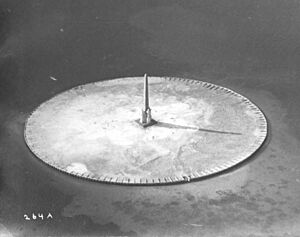Flagler Monument Island facts for kids
Quick facts for kids
Flagler Memorial Island
|
|
|---|---|

Westward view of the island
|
|
| Country | United States |
| State | Florida |
| County | Miami-Dade County |
| City | Miami Beach |
| Area | |
| • Total | 0.007 sq mi (0.02 km2) |
| • Land | 0.007 sq mi (0.02 km2) |
| • Water | 0.0 sq mi (0 km2) 0% |
| Elevation | 3 ft (0.9 m) |
| Population | |
| • Total | 0 |
| Time zone | UTC-05 (EST) |
| ZIP Code |
33139
|
| Area code(s) | 305, 786 |
Flagler Memorial Island is a small, man-made island in Biscayne Bay, Florida, near Miami Beach. No one lives on this island. It was built to honor Henry Flagler, an important person who helped develop Florida.
In the middle of the island stands a tall, pointed stone pillar called an obelisk. It is about 110 feet (33 meters) high. At the bottom of the obelisk are statues that represent different ideas. This monument was built in 1920, a few years after Henry Flagler passed away in 1913.
Contents
Island Changes and Care
Unlike some other islands nearby, Flagler Memorial Island was not built with a strong wall to protect its edges. Because of this, strong ocean currents and storms like hurricanes have changed its original round shape over time.
Different types of plants, including some that are not native to Florida, have grown all over the island. In 1994, a special project helped clear some areas near the monument. They also added large rocks to protect the shoreline and created sandy beaches. These changes made the island a nice spot for visitors to enjoy activities like volleyball and bonfires.
However, nature can be powerful. In 2005, Hurricane Wilma washed away much of the sand, leaving some picnic tables partly underwater.
The island is looked after by Miami-Dade County. They provide picnic areas and trash cans. The monument itself has faced challenges from harsh weather and general wear and tear. The City of Miami Beach has worked to fix the monument in the past, but its lights are currently not working, and the island needs more repairs. Even though no one lives there, it's considered a part of the City of Miami Beach.
Island History
The idea for the monument and the island came from Carl G. Fisher, who helped create Miami Beach. He paid $125,000 to build the obelisk and the four statues in 1920. Later, in 1939, his company gave the land to the City of Miami Beach.
During the early digging work in 1919, workers found an old war club. Experts believe it belonged to the Tequesta, a Native American tribe who lived in the area long ago. This club is now kept safe in a museum in Florida.
Looking After the Monument
Since the island and monument were given to Miami Beach in 1939, different groups, including the city, county, and private organizations, have helped with its care. In 1998, a fire started by a picnicker damaged many trees and plants that had been part of a restoration project.
The monument has faced some challenges over the years. There is a fence around the base to help protect it from damage. The monument has been repaired and lit up at night, but the lights are currently broken, and the island needs more care.
The Statues of the Island
The statues at the base of the monument were designed by a sculptor named H.P. Peterson. They were paid for by Carl G. Fisher and his friends. These four statues face the four main directions (north, east, south, and west). Each one represents an important part of Miami Beach's story.
- North-facing statue: This statue shows a man in a Roman toga, holding a scroll and a small building. He represents industry or hard work. Parts of this statue are damaged from weather.
- East-facing statue: A female figure wearing a dress and cape faces east. She holds books and reaches out as if welcoming someone. This statue has cracks that show the metal inside, which means it needs repair.
- South-facing statue: This statue is of a sailor, shielding his eyes from the sun. He holds a shovel and sits on a plant. He represents the sea and exploration. This statue is also very damaged and might be unsafe.
- West-facing statue: A female figure in a long dress with a crown represents prosperity or wealth. She holds a cornucopia (a symbol of plenty) and a purse. Her right hand is badly damaged.
Gallery
-
Flagler Memorial Island as seen from a boat on Biscayne Bay



